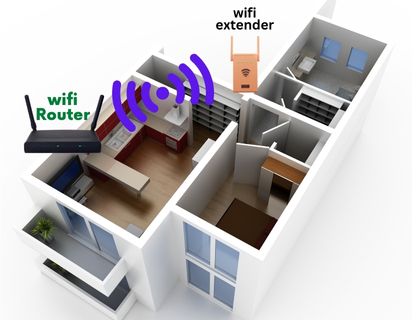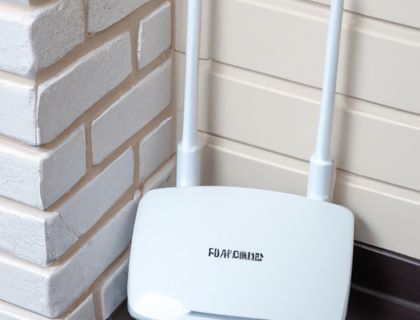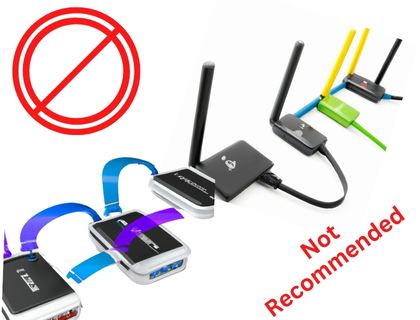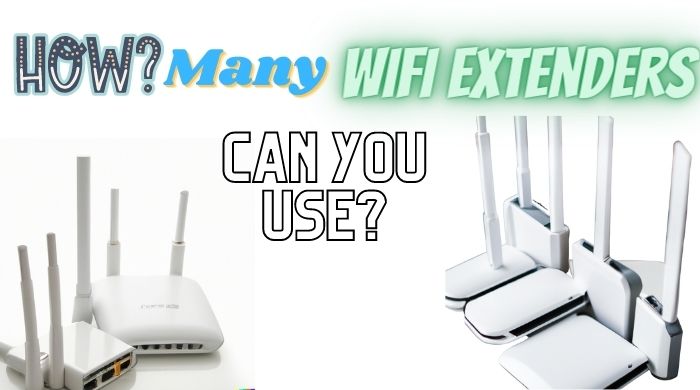A WiFi network is essential to our daily lives, and a strong and reliable connection must be maintained. But, the coverage is sometimes insufficient, and the signal strength decreases, causing a slow or spotty internet connection.
How Many Wifi Extenders Can You Use
WiFi extenders can help to extend the reach of your existing WiFi network, providing better coverage and stronger signals. But, many people wonder, “How many WiFi extenders can I use?” In this blog post, we will discuss the answer to this question and provide tips on optimizing your WiFi network with multiple extenders.
Using multiple WiFi extenders is a viable solution, but it is essential to be mindful of potential limitations and drawbacks. Connecting more than two extenders to your router is possible without difficulty, but linking one extender to another through wireless means is not advisable.
Failure to utilize different channels for each extender may result in signal interference. If one or two extenders do not provide sufficient coverage, it may be a good idea to consider a mesh WiFi network alternative.
Factors to Consider When Determining the Number of WiFi Extenders:
You can generally use up to three to four WiFi extenders in a single network (Not in series or chain). Your network’s specific requirements will determine the optimal number of extenders.
Before adding additional WiFi extenders, it is important to assess the current network performance and identify any potential issues that could limit the number of extenders you can use. There are a few factors that can help you decide about the number of WiFi extenders that can be used in your network:
The layout of the Building:
The design and structure of a building, including walls, doors, windows, and other obstructions, is a critical factors in deciding the number of WiFi extenders required for optimal coverage. A building with many walls or large open spaces can cause the WiFi signal to weaken or become patchy, leading to the need for more extenders to maintain coverage.
Conversely, a large area building with an open floor plan may require more extenders. The layout of the Building is thus an essential consideration when determining the number of WiFi-extenders.
WiFi Router Capacity:
Most WiFi routers have a limit to the number of devices that can connect to the network at the same time. The maximum number of devices can vary from router to router, with some supporting up to 50 or more devices. But using the WiFi extender for this purpose might affect your network speed and performance.
Placement of WiFi Extenders:
Obstacles, walls and interference from other devices, such as microwaves, cordless phones, and other wireless devices, can affect the coverage.
Be sure to place the extenders in locations where they can receive a strong signal from the router and provide the best coverage for your devices. It is also recommended to use the same brand and model of WiFi extenders for best results, as different brands and models may differ.
How Walls and Obstacles Affect the WiFi
Walls and other obstacles can have a significant impact on the performance of your WiFi network, especially when it comes to the use of WiFi extenders. The following are ways in which walls and obstacles can affect the performance of your network and limit the number of WiFi extenders you can use:
Signal Loss: Walls and other obstacles can cause signal loss, reducing the overall coverage area of your WiFi network. When the signal from your router is weak, you may need additional WiFi extenders to compensate for the signal loss and extend the coverage area.
Interference: Walls and other obstacles can cause interference, limiting your WiFi network’s performance. Interference can cause slowdowns, disconnections, and other issues that can affect the overall performance of your network.
Dead Spots: Walls and other obstacles can create dead spots or areas of your home or office where there is little or no WiFi signal. To address these dead spots, you may need to use additional WiFi extenders or consider other solutions, such as a mesh network system.
When it comes to the number of WiFi extenders you can use, the impact of walls and obstacles will depend on the specific requirements of your network. To determine the optimal number of WiFi extenders for your needs, it is important to conduct a network analysis and assess your network’s current coverage and performance. It will help you identify areas of weak or dead spots and determine the best locations for additional WiFi extenders.
Is Connecting WiFi Extenders in Series a Recommended Approach?
Linking WiFi extenders in a series or chain is not a recommended approach. In this method, the first extender is connected to the main router, followed by connecting the next extender to it.
Although this may seem an effective way to extend your WiFi network’s range from the primary router, it usually leads to poor network performance.
This type of setup results in reduced speeds, higher latency, and overall subpar network performance. Devices that connect to the second extender have their connections go through the extender wirelessly, then the first extender, and finally the router, leading to further delays and speed reductions.
Can you use 2 WiFi extenders at the same time?
Yes, you can use two WiFi extenders simultaneously to extend your network’s coverage area and improve its performance. However, the extenders should be appropriately configured to avoid any potential problems.
It includes setting them up with the same network name (SSID) and password, placing them in optimal locations, and minimizing interference from other devices.
Here’s an example of how you can use two WiFi extenders:
First Extender:
Using an Ethernet cable, connect the first extender to your router. The extender will receive the network signal from your router and broadcast it as a separate WiFi network.
Place the first extender in the right location: Place the first one in a location that provides optimal device coverage. Avoid placing the extender in areas with high interference levels, such as near microwave ovens or cordless phones.
Second Wifi Extender
Connect the second extender to the first extender using an Ethernet cable. The second extender will receive the network signal from the first and broadcast it as a separate WiFi network.
Place the second extender in the right location: Place the second extender in a location that provides optimal device coverage. Ensure the extender is not placed near microwave ovens or cordless phones that cause high levels of interference.
Follow the manufacturer’s instructions for configuring your router with multiple WiFi extenders. All extenders and the router should use the same SSID and password. You will be able to connect your devices without interruptions. These steps will help you expand your WiFi coverage area and enhance your network’s performance using two WiFi extenders.
It is important to keep in mind that adding multiple extenders can potentially slow down the speed of your Internet, so it’s important to follow best practices and monitor the performance of your network regularly.
Why Placement of the Router and WiFi Extenders is Important?
Placing the WiFi extender in the right location can help minimize the number of extenders needed to provide adequate device coverage. The following are some tips to help you find the best location for your WiFi extender:
Midway Point: Place the extender between your router and the area where you need coverage. It will help ensure that the signal from the extender is strong enough to reach your devices without being too weak or too strong, which can lead to reduced performance.
Clear Line of Sight: Ensure that the WiFi extender has an unobstructed view of the router and the area requiring coverage. Avoid placing the extender behind walls, doors, or other obstacles, as these can block or reduce the signal from the extender.
High Up: Place the extender on a high shelf or mount it on a wall to avoid interference from other devices or physical objects. It will help ensure that the signal from the extender is not obstructed or reduced by other devices or objects in the room.
Away from Interfering Devices: Place the extender away from other electronic devices, such as microwave ovens, cordless phones, and baby monitors, as these can interfere with the signal from the extender.
Test Multiple Locations: If you are unsure where to place the extender, try testing multiple locations to find the one that provides the best performance. You can use a network analysis tool to assess the performance of your network and determine the optimal location for the extender.
By following these tips and placing your WiFi extender in the right location, you can help minimize the number of extenders needed to provide adequate device coverage.
Is There a Limit to How Many Extenders I Can Have?
The number of WiFi extenders you can have in a single network is limited. The exact limit depends on several factors, including the capacity of your router, the complexity of your network configuration, and the level of interference from other devices.
You can generally use up to two to three WiFi extenders in a single network. The optimal number of extenders will vary depending on your network’s specific requirements.
Before adding additional WiFi extenders, it is important to assess the current network performance and identify any potential issues that could limit the number of extenders you can use.
Additionally, using fewer WiFi extenders can lead to reduced performance, signal overlap, and other issues that can impact the overall quality of your network. To ensure optimal performance, it is recommended to use the minimum number of range extenders and extend the network is ethernet wire to
Recommendations If You Use Multiple Extenders
If you are using multiple range extenders, it is important to follow these recommendations to ensure optimal performance:
Placement: Place each extender in a location that provides optimal device coverage. It is recommended to place the extender in an area with a strong signal from the router, such as a central location.
Interference: Minimize interference between the extenders and other devices by choosing the right channel and frequency. You can use a network analysis tool to assess the performance of your network and determine the optimal channel and frequency for your extenders.
Load Balancing: If possible, configure the extenders to use load balancing, which distributes the network traffic evenly among all extenders. It can help ensure that all devices have the same level of performance, regardless of their location in the network.
Monitoring: Regularly monitor the performance of your network to identify and resolve any issues. You can use a network analysis tool to assess the performance of your network and make any necessary adjustments.
By following these recommendations, you can ensure optimal performance and coverage when using multiple WiFi extenders.
FAQs
Can I use 2 WiFi extenders with 1 router?
Yes, you can use multiple WiFi extenders with a single router. It can help to extend your network’s coverage area and improve your devices’ performance. When using multiple WiFi extenders, it is important to follow the best practices and recommendations we just described.
Do multiple WiFi extenders slow down the Internet?
Multiple WiFi-extenders can potentially slow down Internet speed, but it depends on various factors. Some of the factors that can impact the speed of your Internet include:
Bandwidth: The amount of bandwidth available to each device on the network can impact the speed of the Internet. The Internet may be slowed down if many devices are connected to your network.
Interference: Interference from other devices can impact the signal quality and speed of the Internet.
Signal Overlap: If two or more extenders overlap in the same area, it can create signal interference and slow down Internet speed. Place the extenders in different areas of your home to minimize signal overlap.
Configuration: Improper configuration of the extenders can also slow down the speed of the Internet.
Ensure that the extenders are configured correctly and optimized according to the manufacturer’s instructions.
While multiple WiFi extenders can potentially slow down the Internet speed, following the best practices mentioned above can help minimize this impact and improve the overall performance of your network.
Conclusion:
Using multiple WiFi extenders can help extend the coverage area and improve the performance of your network. To maximize the benefits of using multiple extenders, it is important to follow best practices such as proper placement, configuration, minimizing interference, and load balancing.
Additionally, monitoring the performance of your network regularly can help ensure optimal performance and resolve any issues that may arise. By following these recommendations, you can successfully use multiple WiFi extenders to enhance the coverage and performance of your network.
